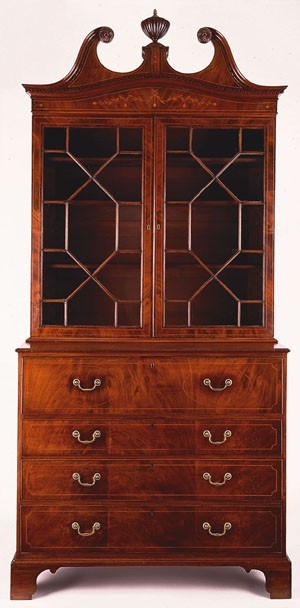
Secretary-and-bookcase, Charleston, 1785–1790. Mahogany and mahogany veneer with white cedar, red cedar, and white pine. H. 105 3/4", W. 48 1/2", D. 24 3/8". (Courtesy, Charleston Museum, Charleston, South Carolina; photo, Gavin Ashworth.) http://charlestonmuseum.org

Detail of the writing compartment of the secretary-and-bookcase illustrated in fig. 1. (Courtesy, Charleston Museum, Charleston, South Carolina; photo, Gavin Ashworth.) http://charlestonmuseum.org
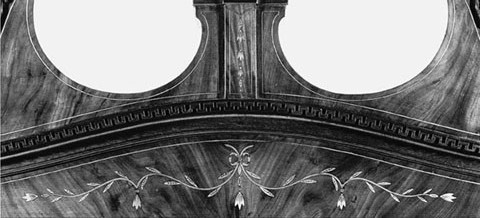
Detail of the pediment of the
secretary-and-bookcase illustrated in fig. 1. (Courtesy, Charleston Museum, Charleston, South Carolina; photo, Gavin Ashworth.) http://charlestonmuseum.org
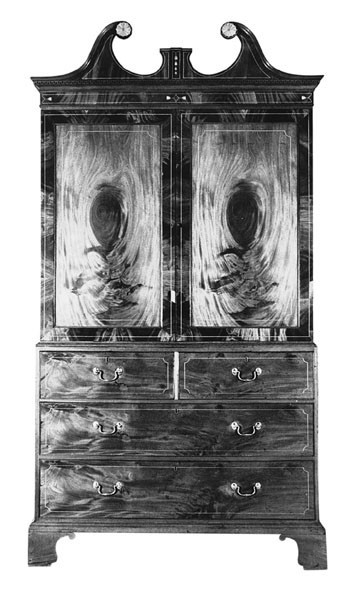


Secretary-and-bookcase on legs, Charleston, 1785–1790. Mahogany and mahogany veneer with cypress and yellow pine. H. 101 3/4", W. 49 13/16", D. 24 7/16". (Courtesy, Baltimore Museum of Art.) The pediment and frieze are constructed on a separate dovetail frame.
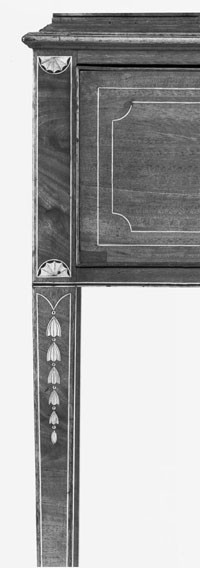
Detail of the leg and drawer inlay on the secretary-and-bookcase on legs illustrated in fig. 6.
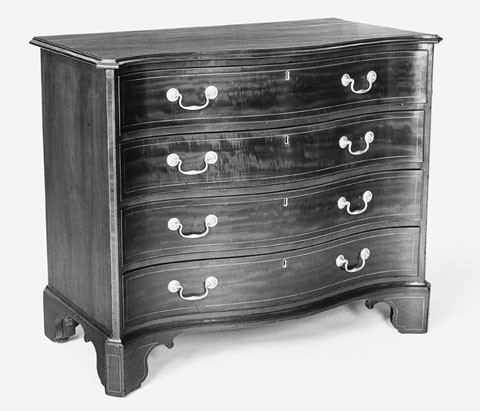
Chest of drawers labeled by William Jones, Charleston, 1788–1789. Mahogany and mahogany veneer with white pine, ash, tulip poplar, and mahogany. H. 34 1/2", W. 42", D. 21 3/4". (Collection of the Museum of Early Southern Decorative Arts.) The drawer-face veneers and stringing are replaced.
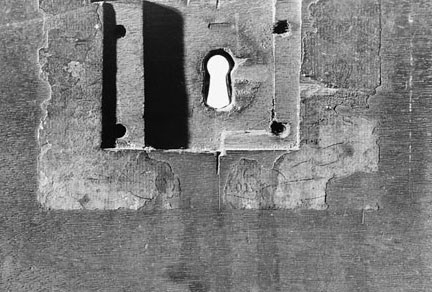
Detail of the label on the chest illustrated in fig. 8.
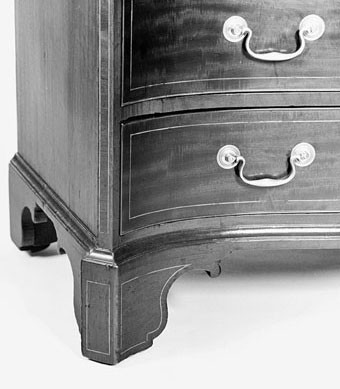
Detail of a canted corner and foot on the chest illustrated in fig. 8.
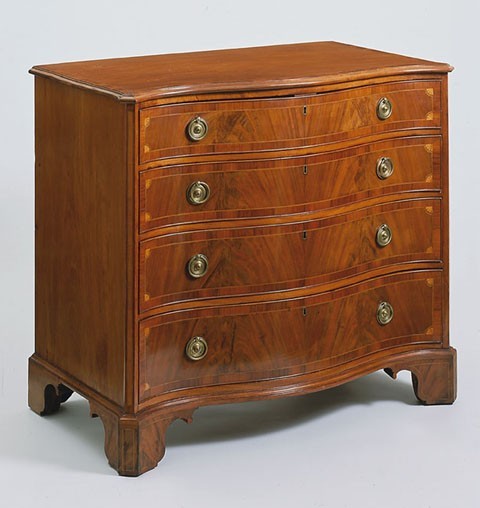
Dressing chest attributed to William Jones, Charleston, 1785–1790. Mahogany and mahogany veneer with white pine, mahogany, and red cedar. H. 37 7/16", W. 40 13/16", D. 23 7/16". (Courtesy, Winterthur Museum; gift of Commander and Mrs. Duncan I. Selfridge.)
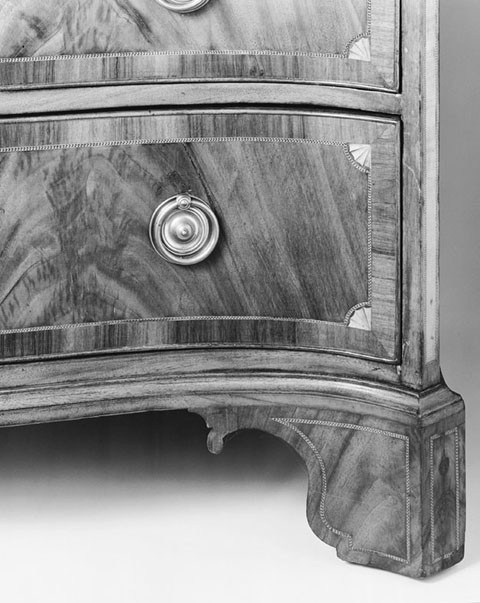
Detail of the veneer and inlay on the drawers, feet, and cants of the dressing chest illustrated in fig. 11.

Detail of the upper drawer of the dressing chest illustrated in fig. 11, with dressing glass deployed.
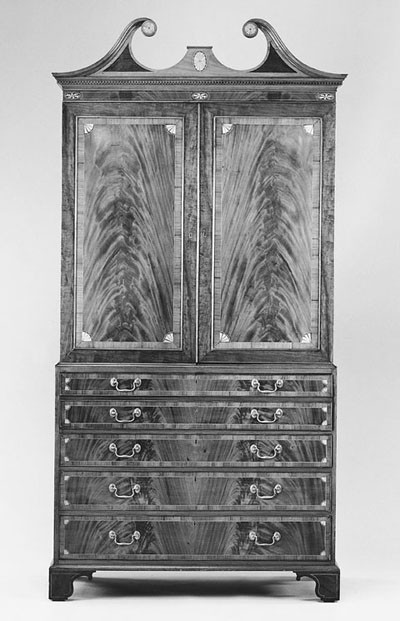
Secretary-press attributed to William Jones, Charleston, 1785–1790. Mahogany and mahogany veneer with white pine, red cedar, and tulip poplar. H. 99 1/4", W. 49 3/8", D. 24 5/8". (Courtesy, Diplomatic Reception Rooms, U.S. Department of State.) Both the upper and lower cases have paneled backs.
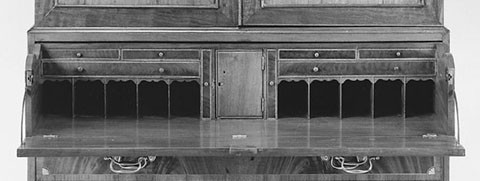
Detail of the writing compartment of the secretary-press illustrated in fig. 14.

Clothespress, Charleston, 1785–1790. Mahogany and mahogany veneer with white pine. H. 91", W. 53 1/4", D. 25 3/4". (Private collection; photo, Dirk Bakker.)
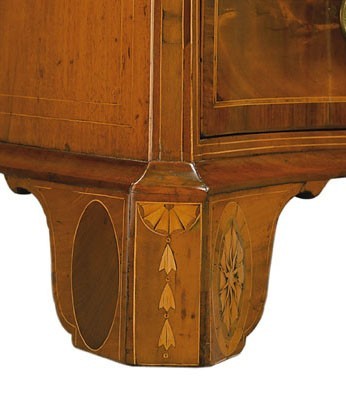
Detail of a foot and canted corner of the clothespress illustrated in fig. 16. (Photo, Museum of Early Southern Decorative Arts.)
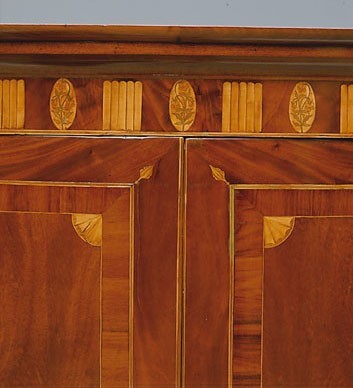
Detail of the frieze of the clothespress illustrated in fig. 16. (Photo, Dirk Bakker.)
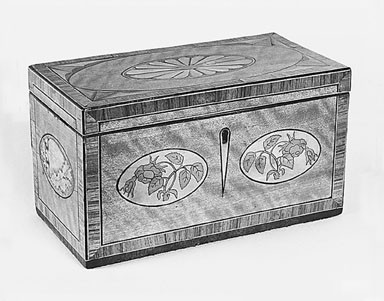
Tea caddy, Britain, 1780–1800. Woods and dimensions unrecorded. (Courtesy, Philip H. Bradley, Inc.; photo, John Bivins.)

Clothespress, Charleston, 1785–1790. Mahogany with white pine. H. 94", W. 51 3/4", D. 24 3/4". (Private collection; photo, Museum of Early Southern Decorative Arts.) The lower right brass has been digitally added to this image.

Detail of the pediment of the clothespress illustrated in fig. 20.
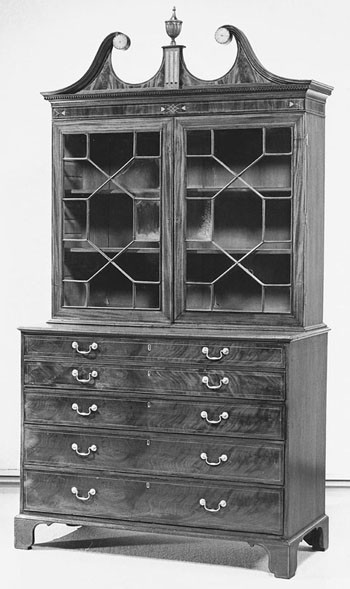
Secretary-and-bookcase, Charleston, 1790–1800. Mahogany and mahogany veneer with red cedar and white pine. H. 104", W. 55 3/8", D. 24 3/8". (Private collection; photo, Museum of Early Southern Decorative Arts.)
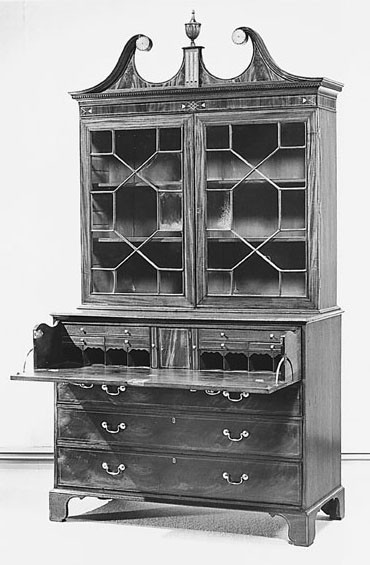
Open view of the secretary-and-bookcase illustrated in fig. 22.

Detail of the pediment of the secretary-and-bookcase illustrated in fig. 22.
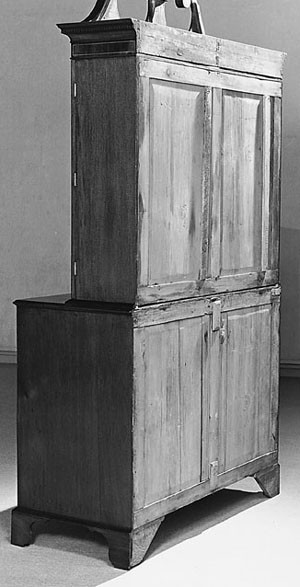
Rear view of the secretary-and-bookcase illustrated in fig. 22, showing the framed pediment and frieze and paneled upper and lower case backs.

Secretary-and-bookcase, Salem, Massachusetts, 1790–1800. Mahogany and mahogany veneer with birch and white pine. H. 96 3/4", W. 43 3/4", D. 24 1/4". (Private collection; photo, Gavin Ashworth.)
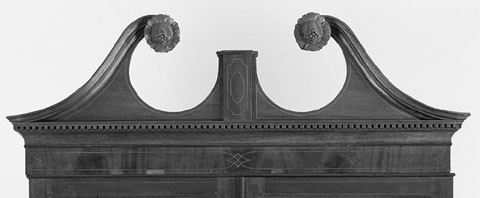
Detail of the pediment of the secretary-and-bookcase illustrated in fig. 26. (Photo, Gavin Ashworth.)
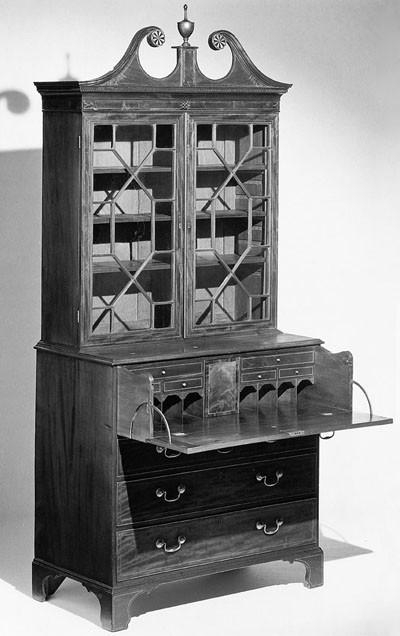
Secretary-and-bookcase labeled by William Appleton, Salem, Massachusetts, 1795–1804 (based upon label address at Charter and Liberty Streets.) Mahogany and mahogany veneer with white pine. H. 97 1/2", W. 43 1/4", D. 24 3/8". (Courtesy, Winterthur Museum.)
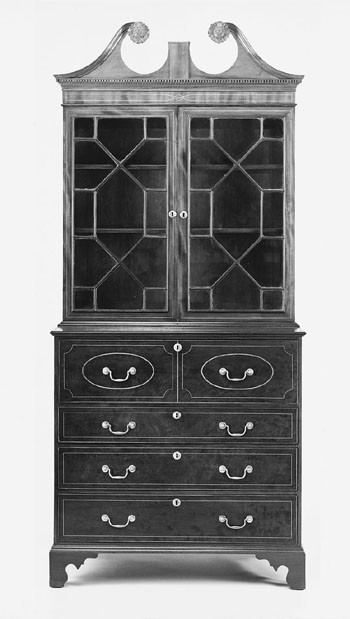
Secretary-and-bookcase labeled by Elijah and Jacob Sanderson, Salem, Massachusetts, 1790–1810. Mahogany and mahogany veneer with red cedar and white pine. H. 97 5/8", W. 43 3/8", D. 24 3/4". (Courtesy, Diplomatic Reception Rooms, U.S. Department of State.)
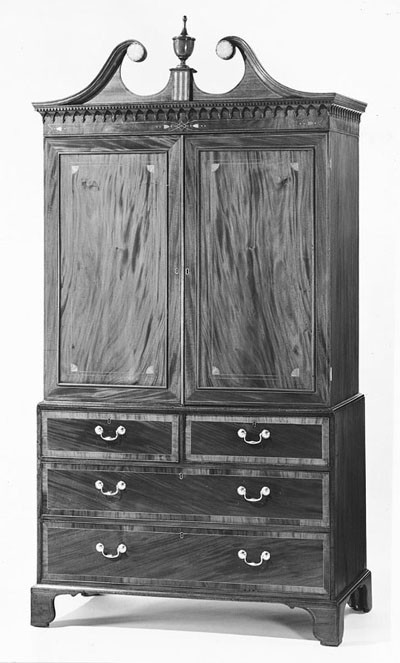
Clothespress, Charleston, 1790–1800. Mahogany and mahogany veneer with yellow pine and white pine. H. 96", W. 50 1/4", D. 24 3/4". (Collection of the Museum of Early Southern Decorative Arts.) The inlaid rosettes and the finial are restorations.
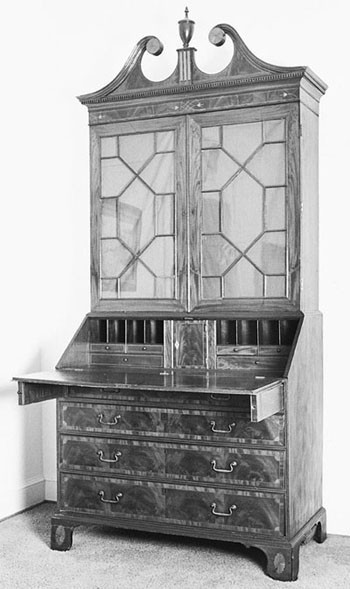
Desk-and-bookcase, Charleston, 1790–1800. Mahogany and mahogany veneer with white pine. H. 983/4" (including finial), W. 45", D. 25". The brasses are replaced. (Private collection; photo, Museum of Early Southern Decorative Arts.)
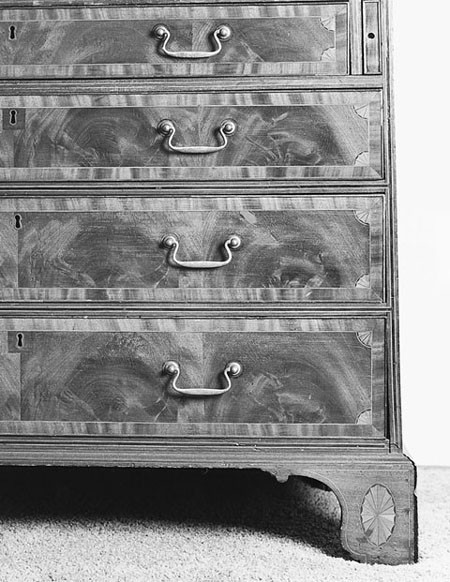
Detail of the lower case of the desk-and-bookcase illustrated in fig. 31.

Chest of drawers, Charleston, 1790–1800. Mahogany and mahogany veneer with red cedar, mahogany, and white pine. H. 37 1/4", W. 41 7/8", D. 22 1/2". (Courtesy, Yale University Art Gallery; gift of C. Stanford Bull.)

Chest of drawers, Salem, Massachusetts, 1790–1800. Mahogany and mahogany veneer with white pine. H. 36 7/16", W. 40 3/8", D. 22 3/8". (Private collection; photo, John Bivins.)

Gentleman’s secretary, Charleston, 1790–1800. Mahogany and mahogany veneer with white pine. H. 115 1/2", W. 76". (Private collection; photo, Museum of Early Southern Decorative Arts.) The door tracery is missing, and the two drawers below the desk drawer are replaced with a cabinet.
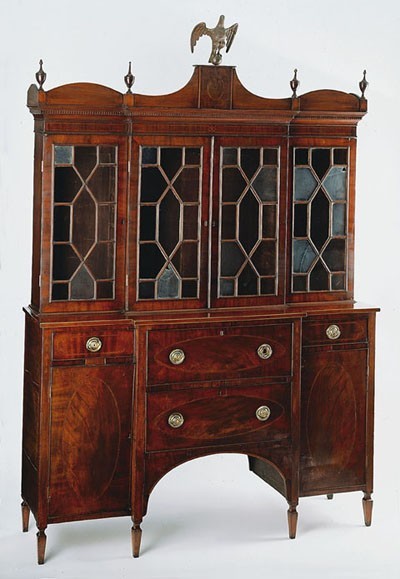
Gentleman’s secretary, Salem, Massachusetts, 1795–1805. Mahogany and mahogany veneer with white pine. H. 99 5/16", W. 67 3/16", D. 18 3/8". (Courtesy, Charleston Museum; photo, Gavin Ashworth.)

Secretary-and-bookcase on legs, Charleston, 1795–1800. Mahogany and mahogany veneer with white pine, tulip poplar, yellow pine, and red cedar. H. 92", W. 42", D. 24". (Courtesy, Sumpter Priddy, III, Inc.; photo, Katherine Wetzel.)
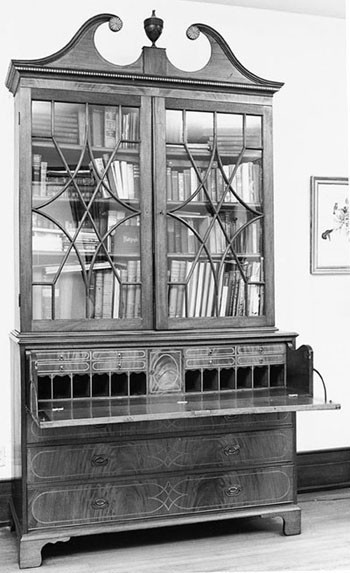
Secretary-and-bookcase signed by Philips & Welch, Charleston, 1800. Mahogany and mahogany veneer with mahogany, yellow pine, and white pine. H. 111 1/2" (including finial), W. 58 1/8", D. 24 1/8". (Private collection; photo, Museum of Early Southern Decorative Arts.)
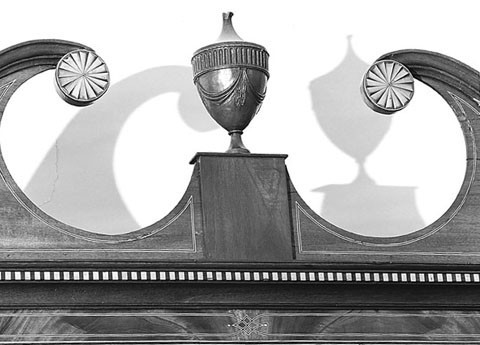
Detail of the pediment of the secretary-and-bookcase illustrated in fig. 38. The top of the finial is missing.
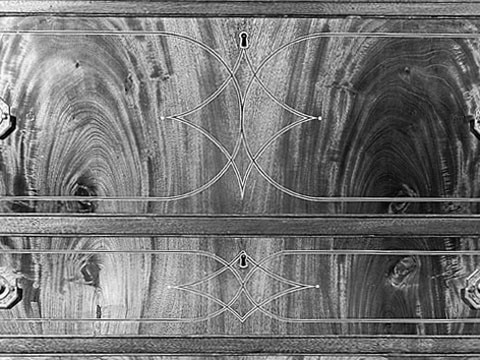
Detail of the lower case of the secretary-and-bookcase illustrated in fig. 38.
